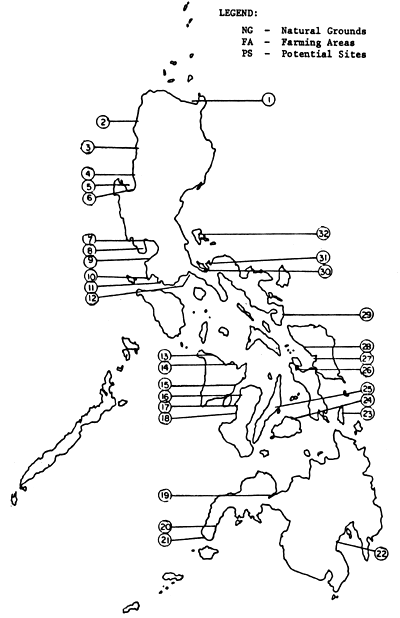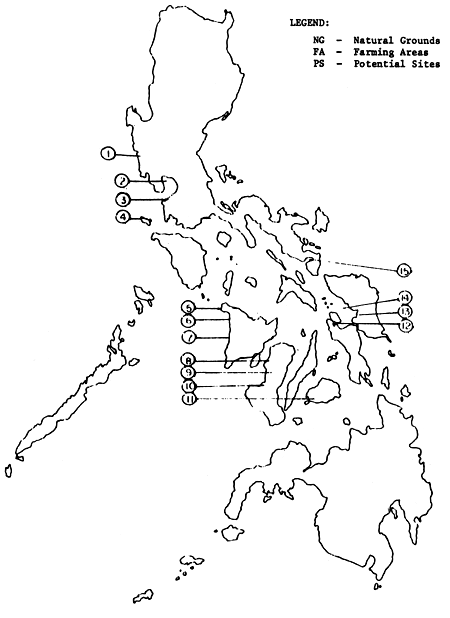Oysters and mussels are the most common molluscs farmed in the country. Oyster farms are located in 17 provinces of the Philippines with major production areas in Cavite and Bulacan provinces which border Manila Bay; Pangasinan in northern Luzon, bordering Lingayen Gulf; Sorsogon in southern Luzon; Capiz and Negros Occidental in the Visayan region. Figure 6 shows the areas where natural populations of oysters are present, existing farming areas and location of potential oyster farming sites. Oyster farming was started in Cavite in 1935 through government demonstration work. After World War II this was reactivated.
Mussel farming is a more recent practice compared to oyster farming. Its expansion took place in the early 1960s. The improved culture method known as the “rope-web” system was developed only in 1974 in Sapian Bay, Capiz. Mussel farming areas are located in Bacoor, Cavite along Manila Bay where there are about 134 farms; Sapian Bay, Capiz approximately 300 farms and Maqueda Bay in Samar, where there are about 250 farms. Figure 7 shows the location of natural mussel grounds, farming areas and potential sites for development of mussel farming.
| 1. | Buguey, Cagayan (NG, FA) |  |
| 2. | Ilocos Norte (NG, FA) | |
| 3. | Ilocos Sur (NG, FA) | |
| 4. | Aringay and Sto. Tomas, La Union (NG, FA) | |
| 5. | Lingayen Gulf and Tambac Bay (NG, FA) | |
| 6. | Agno River, (Manat, Binmaley Pangasinan and Davel, Dagupan City (NG, FA) | |
| 7. | Binuangan and Malolos, Bulacan (NG, FA) | |
| 8. | Abucay and Mariveles, Bataan (FA, NG, PS.) | |
| 9. | Cavite (Bacoor and Ternate Bays) (NG, FA). | |
| 10. | Balayan Bay, Batangas (NG, FA) FA) | |
| 11. | Batangas Bay (NG, | |
| 12. | Tayabas Bay (PS) | |
| 13. | Makato, Aklan (PS) | |
| 14. | Sapi-an Bay, Capiz (NG, FA) A) | |
| 15. | Banate Bay, Iloilo (NG, FA) | |
| 16. | Bacolod (Port of Banago) (NG, FA) | |
| 17. | Binalbagan and Hinigaran Negros Occidental (NG, FA) | |
| 18. | Himamaylan, Negros Occidental (NG, PS) | |
| 19. | Panguil Bay, Misamis Occidental (PS) | |
| 20. | Luuk, Bongao Cave, Sacol Island Zamboanga del Sur (PS) | |
| 21. | Atoll Lagoon, Sta. Cruz Zamboanga del Norte (PS) | |
| 22. | Malalag Bay, Davao City (NG. FA) | |
| 23. | Del Carmen Dapa, Surigao del Norte (PS) | |
| 24. | Calape, Bohol (NG, FA) | |
| 25. | Cebu (NG, FA, PS) | |
| 26. | Leyte (PS) | |
| 27. | Maqueda Bay and Jiabong Samar (PS, NG) PS) | |
| 28. | Catbalogan, Samar (PS) | |
| 29. | Sorsogon (NG, FA) | |
| 30. | Calauag Bay, Quezon (PS) | |
| 31. | Alabat Island, Quezon (PS) | |
| 32. | Polilio Island, Quezon (PS) |
Figure 6. Natural oyster grounds, farming areas and potential sites in the Philippines (From: SCS/82/WP/103)
The Philippines has an even temperature which is ideal for year round farming of oysters and mussels. Vast areas with satisfactory salinity, current and phytoplankton are available. Areas which do not have natural stocks of these molluscs could be used as transplantation of seeds from natural grounds to set up a spawning stock to provide natural setting and future self-sustaining population.
| 1. | Masinloc, Zambales (NG, FA) |  |
| 2. | Binuangan, Obando, Bulacan (NG, FA) | |
| 3. | Bacoor and Binakayan Cavite (NG, FA) | |
| 4. | Tayabas Bay, Quezon (FA, PS) | |
| 5. | Aklan (PS) | |
| 6. | Sapian Bay, Capiz (NG, FA) | |
| 7. | Banate Bay, Iloilo (NG, FA) | |
| 8. | Bacolod City (NG, FA) | |
| 9. | Binalbagan and Hinigaran Negros Occidental (NG, FA) | |
| 10. | Himamaylan, Negros Occidental (NG, FA) | |
| 11. | Bohol (PS) | |
| 12. | Babatngon, Leyte (PS) | |
| 13. | Maqueda Bay, Samar (NG, FA, PS) | |
| 14. | Catbalogan, Samar (FA) | |
| 15. | Sorsogon Bay, Sorsogon (PS) | |
Figure 7. Natural green mussel grounds, farming areas and potential farming sites in the Philippines (From: SCS/82/WP/103)